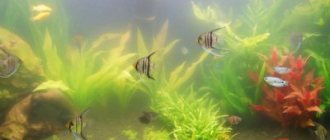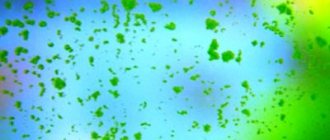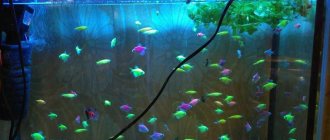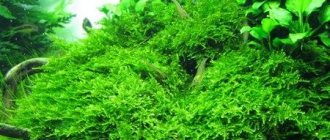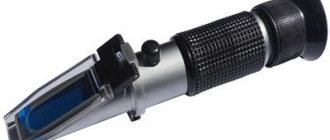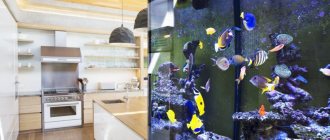Why can't you pour?
Do not completely fill the aquarium with boiled water.
This is due to its too low hardness and low oxygen concentration. An exception can be made for fish that have lived in such an environment since birth . Their immunity and body are already accustomed to these conditions.
However, some aquarists ignore all precautions and fill the tanks with boiled water. But it is important to pay attention not only to the advantages of its use, but also to the disadvantages.
Pros of boiling:
- carbonate hardness of water decreases;
- infections, fungi and bacteria die;
- the concentration of chlorine, which is often found in tap water, decreases.
Reducing water hardness is not always beneficial for the health of the inhabitants.
Some fish are contraindicated in environments that are too soft. Therefore, it is important to know the parameters suitable for life of each species. Despite the advantages, boiling has a number of significant disadvantages:
- A significant part of the microflora dies. Not all microorganisms in tap water are harmful. Some of them help improve immunity and develop resistance to diseases.
- Oxygen concentration decreases. Because of this, the fish become weak, begin to get sick more often, and in some cases, pestilence occurs.
- The aquarist faces significant difficulties with each water change (especially in large-volume aquariums). This is due to the need to boil about 40-70 liters of water at a time (excluding boiling).
Thus, an aquarium filled with boiled water will not only bring health problems to its inhabitants, but will also cause a lot of trouble for its owner.
Step-by-step instructions for preparing at home
Each type of water has its own optimal indicators.
Type H2O
What kind of water should be poured into the aquarium?
Tap
Can only be used after standing for a while.
Pros:
- budget and convenient option;
- microorganisms live in it.
Minuses:
- increased rigidity;
- The possibility of pathogenic bacteria entering cannot be ruled out.
Boiled
Suitable only for those fish that have lived in boiled water since birth.
Pros: absence of harmful microorganisms and bacteria.
- when boiling, not only harmful, but also beneficial microbodies are killed;
- for large aquariums you will need to boil the water several times;
- hardness is below normal.
Is it worth adding boiled H2O to the existing one?
If you urgently need to replace the water, but there is no prepared water in advance, then you are allowed to add boiled water, but not more than 10% of the total volume of the tank .
The aquarist does not always have time to prepare the water for the weekly change. In this case, the fastest option remains effective - boiling. But replacing the usual volume (30-35%) of aquarium water with new boiled water can lead to disastrous consequences.
During replacement, be sure to place the fish in a tank with old water. It is recommended to keep them there for 3-4 hours so that the new water has time to take on the parameters of the one that was already in the aquarium.
To make the addition of a new “type” of water as unnoticeable as possible for the fish,
it is recommended to perform the following steps:
- Increase the power of the aerator. This way the oxygen concentration in the aquarium will remain virtually unchanged.
- Increase lighting. Adding brightness to the lighting will accelerate the growth of plants, which, in turn, will also synthesize oxygen.
There is no need to worry about the lack of beneficial bacteria in boiled water. 2-3 days after adding, they will begin to reproduce themselves due to the vital activity of fish and plants.
Despite the absence of a significant effect of adding boiled water to the aquarium, it is better to perform this procedure at a time and only if absolutely necessary .
If the fish have already lived in an aquarium where there was only boiled water, then it can be added to the tank without special preparation and in the required volume.
I need your help regarding the aquarium))
Yanishel Vanilla Sky
1. I would not launch mollies. It’s better to have a couple of small catfish (golden ones, for example) 2. yes, any, floating on the surface 3. a heater is needed if the room temperature is below 22 degrees. 4. buy everything you need for aquaculture (soil, decorations, plants, filter), process it, fill it with tap water and let it sit for a week, then do a water change (20%) and start it healthy 5. The soil is sold in the store, usually at The packaging says what volume the package is designed for. Choose medium soil. Rinse and boil before storing. 6. You can use an ampoule
Marina Goncharova
For every centimeter of fish there is 1 liter of water. This is an aquarium calculation. 20 liters is not enough for these fish; the guips breed well. They don’t need heating; room temperature will do. Any kind of plants, dig algae into the soil, if you buy special soil for plants, and cover everything with beautiful stones on top, the plants will develop in height and width. Approximately 5 cm of soil should be poured. The water can be settled, or you can do everything with a preparation, without settling. Any snails, no matter how small or large.
Cat "Peach"
1 Probably normal, we keep 2 scalars and 2 goldfish, they get along well! 2 We have moss. But simple algae will also do. 3 Both guppies and swordtails have died. Maybe it depends on the temperature, but I think a room one will do) 4 We didn’t insist 5 we have 19 stones of different sizes, it’s ok for fish 6 The most common snails, if you need to clean the aquarium then it’s ok.
Olga K
I have 23 aquarium fish in my aquarium with a capacity of 140 liters and I can’t do any more. They are cramped and have little air. They are growing. The water temperature should be 24 degrees - this is the norm. Buy a good water filter. You don’t need a lot of soil, because all the debris accumulates in it, and this can lead to fish illness. I don’t take live plants, it’s a lot of hassle. A couple of grottoes, beautiful shells, inanimate plants of all kinds of colors, nothing at all. We defend the water for a day. There are different fish, only compatible ones, some bite. We have swordtails, guppies, molynesias, angelfish, and catfish. We live together, except that the angelfish bit off the tail of one guppy. Oh, there are veil tails, but they are such swallowers that they steal all the food.
Heat Lover
Of course, 20 liters will not be enough, but for the first time it will do. Any aquarium requires heating, because at room temperature the fish will be cool. Comfortable water temperature is approximately 25-27 degrees. To measure, you need to purchase a thermometer. The soil for such a volume is not very coarse. It must be processed before use. We wash the soil with boiling water and thoroughly heat it in the oven or in a frying pan. We fill it with a thickness of approximately 1.5-2 centimeters. Fish need to be sorted into predatory fish, etc. Herbivores, if you keep them together, they will simply eat each other. And the most important thing for an aquarium is not to forget to install a water filter. Good luck.
Count de Wall
I agree with Nastya. Mollies are both cramped and cold - they like it warmer - 25...28 degrees. Otherwise, they will quickly die from a cold. Swordtails are also at risk. Thermostat and filter blower are MANDATORY. The water is changed once a week to a settled volume of 1/4…1/5. If you pour it straight from the tap, everyone will die instantly from the bleach. In general, such a small aquarium is a huge problem; in an aquarium, the larger it is, the easier it maintains biological balance and the easier and less often it can be cared for. Ampoules will quickly make everything dirty and eat the plants, place about 4 snails in small coils and that’s enough. And under no circumstances overfeed - all the troubles are due to the food. Once a day and exactly as much as they can eat in 5 minutes. Otherwise, water decay + disease Light - 12 hours and no more, otherwise it will quickly become overgrown with Blackbeard and the water will bloom - get rid of the horseradish. Calculation of this is 3 liters of water for 1 medium-sized fish with a blower and filter. Hence the maximum population of your mini-crematorium = 7...8 fish. If only there are ten goops. And no more!
Ta Da version.
Plants are better live, but you can use a couple of artificial ones; the aquarium is too small for a large number of fish. It will be comfortable, but if the temperature at home is not lower than 25 degrees. You can dilute raw water with boiled water (cooled) 1k 2m soil, preferably pebbles, an embankment, a small house, and some shells. It's better not to have snails. they multiply quickly and in large numbers.
ELENA DAVYDOVA
Try drinking the water in the chlorine pool yourself. I advise you to first buy everything, fill it with water and plant the plants. Let the aquarium begin to create its own microenvironment. And then, when everything is ready, you can buy fish. Don’t forget about oxygen, fish can’t live without it
Ivan Bolshakov
In such a volume, without any heaters or other equipment, you can contain a flock of 10-12 cardinals. They will multiply. The plants are the most unpretentious - vallisneria, herringbone, etc., but grass already needs light. I don’t recommend getting a Molly - they are heat-loving and only have the size of one and a half pieces.
WorldCG
1) Do not place more than 5 fish (from those listed) in a 20-liter aquarium 2) You can buy any plants. When purchasing them, they will give you any advice. The main thing is that there are not too many of them. Well, so that you can see the fish and so that the aquarium does not become too clogged due to algae. 3) If the room temperature is not lower than 20 degrees (you can check with a thermometer), then you can do without a heater. 4) Be sure to infuse water. What could be the consequences? The fish just might die. 5) The soil can be chosen according to your desire and taste. It depends on what kind of interior is designed, so to speak. It really depends on the owner and his taste. I remember before, we just collected small gravel, boiled it several times and used it. But now I think there is a special primer on sale. How to use it... will also be explained in the store. I advise you not to use gravel, but rather use sand. Looks prettier. 6) From aquarium snails... I recommend Ampularia. He held them himself. They are so yellow-orange. From personal experience I know that they play the role of cleansers well. Yes, and beautiful.
Demar
for 20 liters, it is better to take 4-6 fish from those listed. Whether heating is needed or not depends on the temperature in the room where the aquarium is located. But these fish are not picky about a certain temperature. There is enough soil to cover the bottom, but not much. You can buy one snail, then you won’t know what to do with it, or instead of a snail you can buy a catfish or ancistrus. They do not need separate food. They just eat what settles to the bottom and lies between the stones, where ordinary fish cannot see. And for catfish, make part of the soil from larger pebbles. For fish, I can recommend barbs. If you want a goldfish, then only one and no one else.
It is impossible to do without settling water. Moreover, the new aquarium must settle and be cleaned of factory dust. The voodoo needs to sit in it for a week, drain it, do it again and only then add standing water. And don’t forget that you can’t wash it with chemicals.
Natalya A.
What kind of fish are they at this stage??? First you have an aquarium, hmm... although it’s difficult to call a 20-liter jar an aquarium, unless it’s a fish tank, set it up correctly so that in case of a bacterial outbreak you don’t put fish in, but it’s simply inevitable!!! The aquarium is up and running in 2 weeks!!! No fish!!!
How will this affect the lives of fish?
If you use boiled water for the first time in an aquarium where another type of water preparation was previously used, then health problems in fish cannot be avoided.
Stress caused by a radical change in the state of the environment and its parameters will entail:
- development of diseases,
- apathy,
- increased aggression, etc.
Boiled water has two fundamental differences from ordinary water:
- low rigidity;
- oxygen content in small quantities.
Low hardness is more of a disadvantage than an advantage , since only a small number of species are able to live in a soft environment. In other fish, under such conditions, osmoregulation (the concentration of fluids inside the body) is disrupted, skin diseases develop and, as a result of increased acidity, the respiratory rate decreases.
Low concentrations of oxygen have a detrimental effect on all species of fish and, in most cases, cause mass pestilence. If you do not notice changes in their behavior in time, you can lose half the population of the aquarium.
When can you add boiled water to an aquarium?
It is recommended to conduct a kind of experiment before completely replacing the water. If you have to completely replace the fluid, before introducing the main fish, add some small and inexpensive pets so that you don’t feel sorry for it. If they survive such a water change, this indicates a fairly good quality of the liquid.
When can you add boiled water to an aquarium?
- Accordingly, it can be used for complete replacement in an aquarium. If such fish died and pestilence began, then you should abandon this idea. Boiling methods can also be used. This method is used only when there are no other options, and the fish die after drinking ordinary tap water.
- Air conditioners help prepare water for the settlement of fish, or partially replace it. Air conditioners contain substances that react chemically with chlorine and other impurities contained in tap water.
- Thanks to this, colloidal complexes arise that protect the mucous membrane of the fish, as well as the gills from damage, which often happens when using chlorinated and unsettled water. Regarding boiled water, replacement is only possible partially, and only if the fish initially live in such a liquid.
What liquid is best to fill the tank with?
Today, almost all aquarists use tap water for their tank. The only difference is in the way it is prepared before use:
Defended. It is one of the most popular and safest options.- Bottled. It does not contain impurities and heavy metals, but has a small range of hardness, which is difficult to select for each inhabitant.
- Distilled. Can only be used to add to old water, but not to completely replace it.
- Rainy. This water can be used to reduce hardness and only in small quantities.
- Melted. It is prepared by placing tap water in the freezer for a day and then defrosting it. It is the safest way to prepare.
Can boiled tap water be added to the aquarium?
Nowadays, almost everyone values their time, so most aquarium owners have no time to boil water or freeze it. Therefore, the most popular option is to use additives. These are a kind of conditioners; they soften the liquid, making it suitable for fish to live in. In some cases, such a liquid can be obtained from a spring.
You can add boiled water to the aquarium:
- Many people actually recommend using purified water, which is available in springs; it is purified with natural minerals and components. However, people living in big cities most likely do not know about the existence of such springs; perhaps they do not exist.
- At the same time, due to the huge amount of sewage water, groundwater can be polluted, so the quality of water in springs is far from ideal. It is not recommended to use distilled water, since it is dead and does not contain dissolved metal salts or microorganisms.
- That is why such water is rarely used to add to the aquarium. Accordingly, boiled water should be used as rarely as possible. However, sometimes this is a necessary measure, especially if the quality of water treatment at wastewater treatment plants in your city has deteriorated. Sometimes fish owners can observe a situation where, when the water is renewed, pestilence begins. This indicates a deterioration in the quality of the liquid.
Is it possible to add boiled water to the aquarium in parts?
If spring water or melt water was previously used, then replacing it with even partially boiled water can cause pestilence for the inhabitants of the aquarium. The use of boiled water is not possible if it is necessary to fill a large aquarium.
Is it possible to add boiled water to the aquarium:
- The process of boiling, cooling, and settling boiled water takes a lot of time. Many people note that there is very little oxygen in it, so the fish may not have enough of it.
- It is necessary to add water to the aquarium once a week, since during the life of the fish, some of the liquid evaporates. Once a month a complete water change is carried out.
- However, it is worth considering that it is best to transplant the fish into a bottle with old, that is, dirty water while cleaning the aquarium. Once the equipment is running and the water is saturated with oxygen, residents can be released.
Basic parameters of aquarium water
Ordinary tap water has neutral parameters. The liquid parameters are adjusted to the needs of aquatic inhabitants. Therefore, it is undesirable to keep fish and plants that need different living conditions in the same reservoir. To ensure that the water in the aquarium meets the needs of the fish, you need to have a thermometer and testers, and take measurements according to the following parameters:
- Temperature. Affects the quality of aeration and spawning processes. When the parameter increases to 28℃, the fish begin to reproduce. The critical point is 35℃. If the water temperature is higher, the inhabitants of the aquarium will die. The lower minimum value is 18℃. In a cold room, use a heater. The best temperature in the aquarium is within +23…+26℃.
- Rigidity. Depends on the concentration of calcium, magnesium and other alkaline earth elements. The unit of measurement is degrees of hardness (dGH, dKH). The optimal water hardness in an aquarium is 5–25 dGh. The parameter changes throughout the day and depends on the season. It is influenced by the inhabitants that absorb salts. Some types of stones and shells increase rigidity. Snails and crustaceans need harder water to strengthen their shells. For neons and some types of bettas, the water should be soft.
- Acidity. This parameter is affected by hardness and temperature, time of day and even aeration. In the morning the pH is higher, in the evening it is lower. The pH level is determined by litmus tests. In an acidic environment the paper will turn red, in an alkaline environment it will turn blue. The optimal pH is 6.5–8. Alkaline water is made with soda and acidified with peat tablets.
Unpretentious fish are able to adapt to different parameters of hardness and acidity, and react painlessly to sudden changes in temperature. Thus, some Killi species can survive at temperatures up to 45℃, cichlids of the tilapia genus - up to 70℃. It is not recommended to do such experiments in home ponds.
Periodic replacement
Every week it is necessary to combine the procedure of cleaning the tank with a partial water change. They do a siphon of the bottom and sanitary pruning of plants. The water is settled in advance. Experienced aquarists recommend updating no more than 30% of the volume at a time. It is no longer recommended so as not to disturb the established biobalance and not create stress for the fish.
Attention! Changes are made more often, up to 3 times a week, if medications are added to the water due to fish illness.
Force majeure circumstances may also arise. For example, dangerous substances got into the aquarium by accident, through oversight or ignorance. In such a situation, it is necessary to do not a replacement, but a complete replacement of the entire aquatic environment. The parameters of hardness, acidity and temperature should be close to the aquarium temperature. The better the parameters are selected, the easier the water change process will be for the fish.
Before pouring water from the tap, settle it and reduce the hardness if necessary. To do this, you need to add distilled or boiled water. If the liquid in the reservoir is prepared using conditioners, you can do the same when replacing it.

